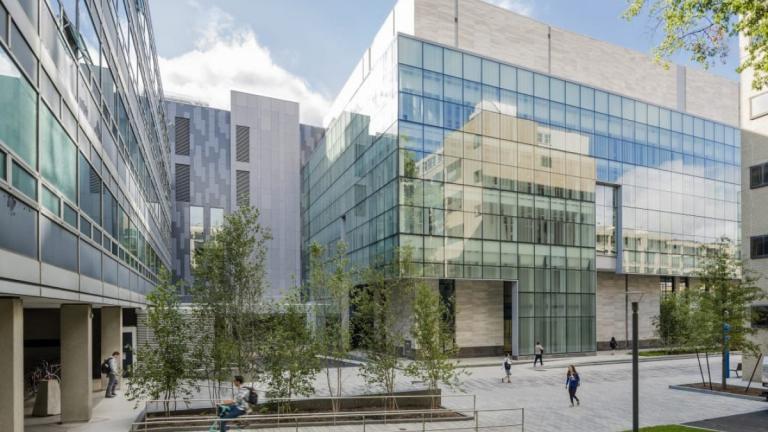
MIT.nano, MIT’s open-access facility for nanoscale science and engineering, has been awarded the American Institute of Architects (AIA) 2021 Committee on the Environment (COTE) Top Ten Award for excellence in sustainability and design.
The annual award recognizes 10 projects, located anywhere in the world, that meet AIA’s Framework for Design Excellence — 10 principles aimed at creating a zero-carbon, equitable, resilient, and healthy built environment. Projects are evaluated on how well they are designed for integration, equitable communities, ecosystems, water, economy, energy, well-being, resources, change, and discovery. In each criterion, MIT.nano excelled.
Located in the heart of MIT’s campus, MIT.nano is a 216,000-square-foot shared resource for MIT faculty, students, and researchers, as well as external academic and industry users. The facility offers state-of-the-art equipment and environmental controls that would be challenging for individual labs or departments to afford or maintain on their own. This shared access was a key component in the creation of MIT.nano, as well as in its selection for the COTE Award — opening the lab to all researchers reduces duplicated efforts across campus to invest in expensive tools and spaces, in addition to fostering collaborative, multidisciplinary research.
Designed by Wilson HGA and completed in 2018, MIT.nano has 47,000 square feet of clean-room suites that make up two two-story spaces in the center of the building. The majority of the clean-room area is Class 100, meaning the air is continuously filtered and replaced every 15-30 seconds to maintain a standard that allows no more than 100 particles of 0.5 microns or larger within a cubic foot of air.
Traditionally, clean-room facilities require a high amount of energy to maintain this low particle count environment. The MIT.nano project team, however, managed to identify primary drivers of energy consumption and tweak these components to optimize performance while minimizing energy use. The team incorporated over 60 energy conservation measures, including a heat recovery system and high-performance curtain wall, resulting in 51 percent energy cost savings and 50 percent greenhouse gas emissions reduction over industry standards.
“MIT.nano was engineered in an MIT way — not only following the standards, but studying the technology behind them to consider how it could be even better,” says MIT.nano Director Vladimir Bulović, the Fariborz Maseeh Chair in Emerging Technology. “This award truly represents a team effort from all of our partners, including MIT Facilities and the Office of Sustainability, to make this building an exemplary structure for sustainability.”
The building also represents MIT’s site-to-system approach for reaching the goal of a net-zero-carbon campus. At MIT.nano, a functional relationship with MIT’s Central Utilities Plant (CUP) supports this balance — the CUP can reuse MIT.nano’s reverse osmosis water in its cooling systems, while MIT.nano relies on the CUP’s distributed energy resource for both thermal and electric energy.
In addition to energy, MIT.nano fits within MIT’s Stormwater and Landscape Ecology Masterplan, achieving stormwater management, resilience planning, and heat-island reduction goals through hardscape, landscape, and building materials. Built in the center of campus, MIT.nano also revitalized a main connection point, turning a former service yard into outdoor spaces for transit and gathering, including the North Corridor and Improbability Walk. Over 100 trees were planted, adding a projected 25,000 square feet of canopy.
The welcoming nature of this outdoor space is continued inside MIT.nano with daylight filtering deep into the lab. Floor-to-ceiling windows line the perimeter hallways, allowing natural light to flow into the facility, and adjacent buildings provide the needed shade. Interior windows into the clean room are multifunctional — allowing light in, inviting passersby a glimpse of the research, and promoting the safety of the researchers through increased visibility.
The building itself has a steel frame primary structure with composite concrete on metal floors and roof decks, a shift from the concrete structures traditionally built for nanoscale research. The change reduced the materials tonnage and reduced embodied carbon by 29 percent. Through a carefully designed construction waste management plan, over 90 percent of construction waste was diverted from landfills.
MIT.nano was built with the future in mind. The building is designed to adapt as both scientific research and the environment around us changes. Generous floor-to-floor heights and additional mechanical, electrical, and plumbing (MEP) load capacity anticipate future tools and renovations; and design for high-hazard occupancy on the fifth floor will allow for future increase in chemical quantities. To account for flood mitigation, a slurry wall construction acts as cutoff walls from groundwater hydrostatic pressure, and the ground floor is elevated six inches above surrounding grade and adjacent connected buildings.
The COTE Award is the latest honor for MIT.nano, following its recent 2020 AIA New England Honor Award and 2020 LEED Platinum certification, the highest designation from the U.S. Green Building Council. MIT.nano has also received the International Institute for Sustainable Laboratories (I2SL) 2019 “Go Beyond” Award; the 53rd annual Lab of the Year Award from R&D Magazine; the 2019 Education Facility Design Award of Merit presented by the American Institute of Architects Committee on Architecture for Education; a Boston Society for Architecture 2020 Honor Award; and national and state 2019 Gold Awards for Engineering Excellence from the American Council of Engineering Companies.





